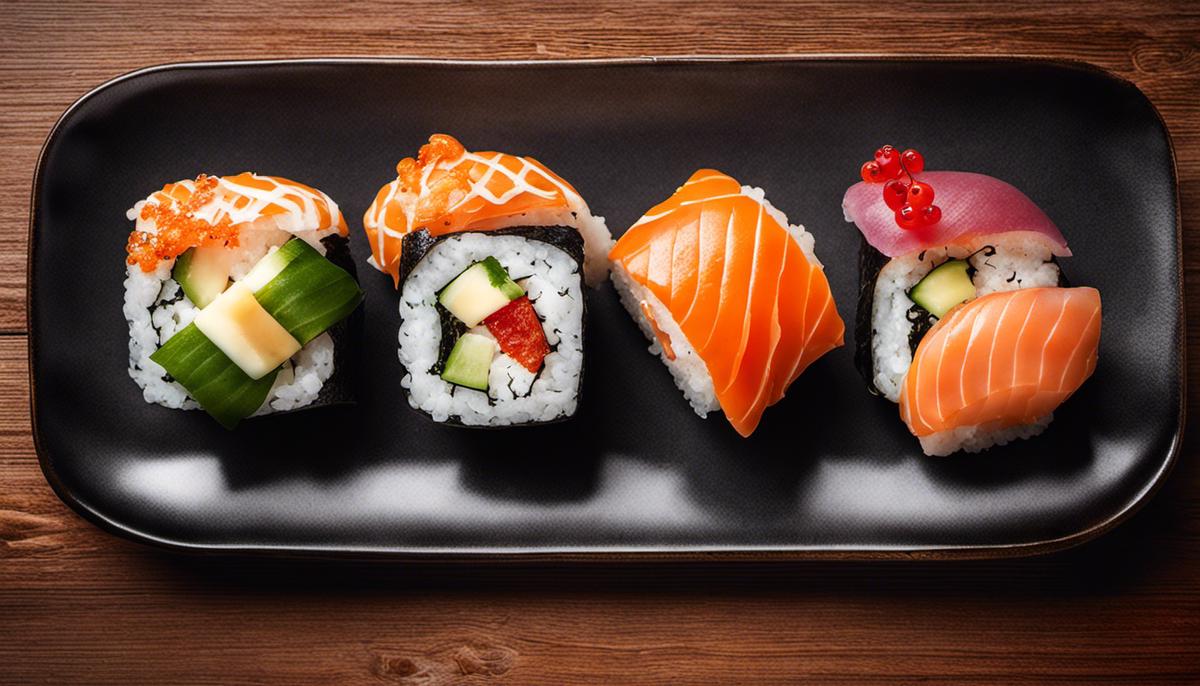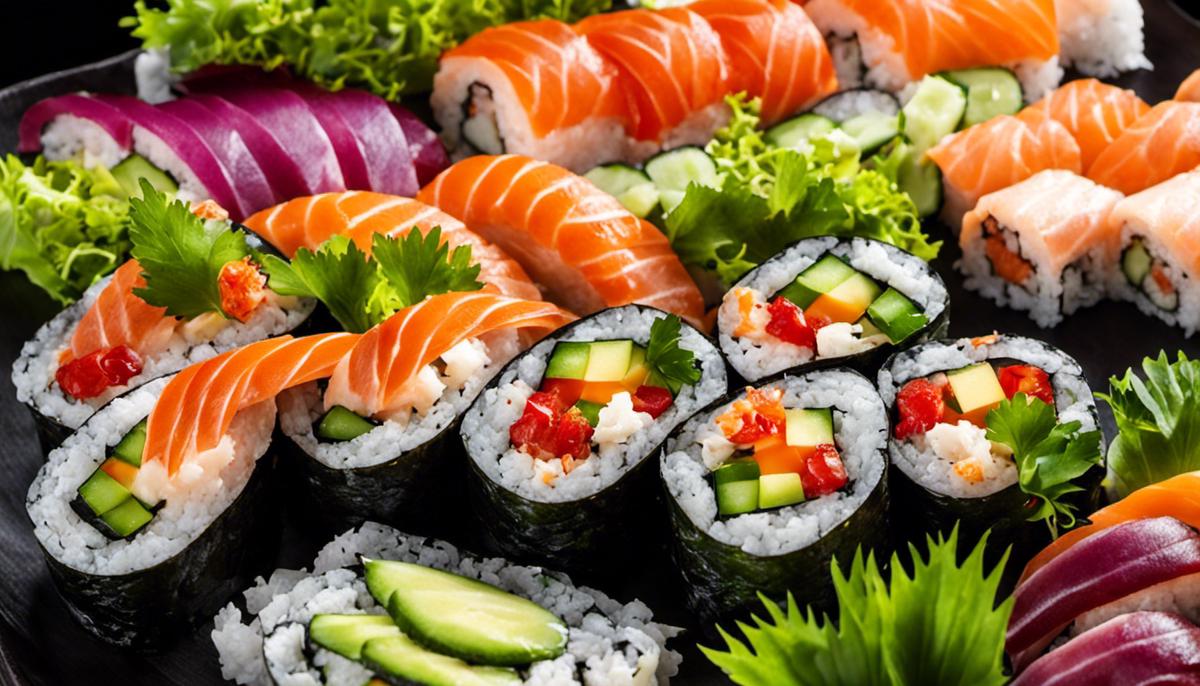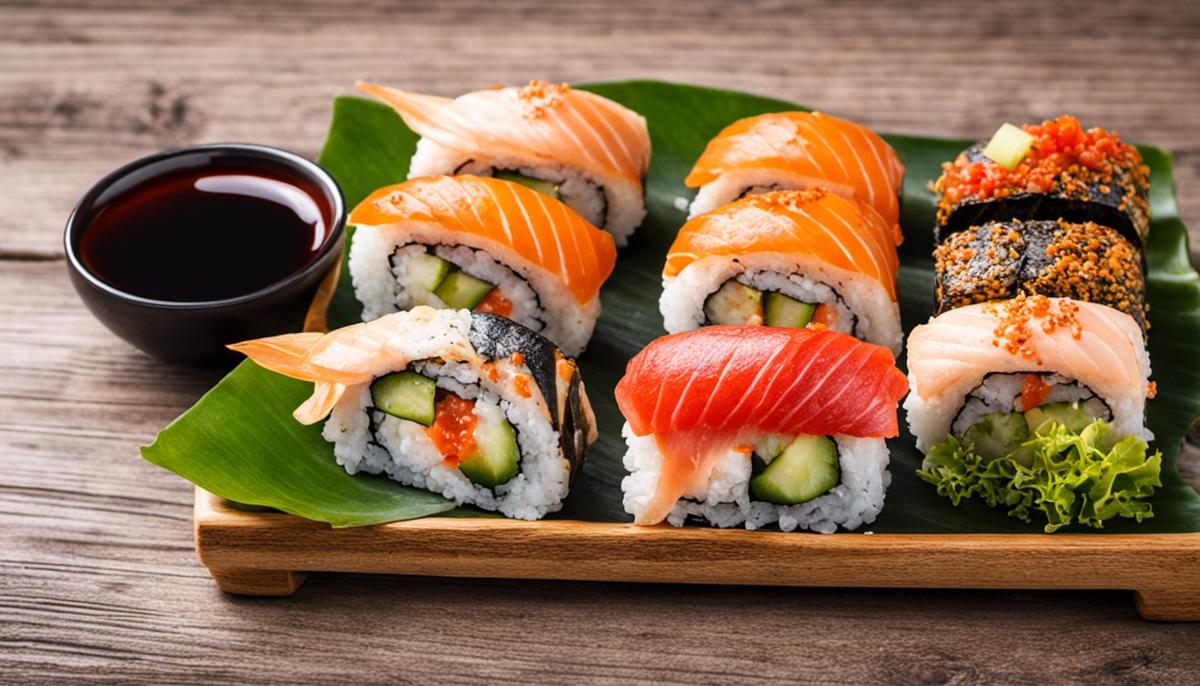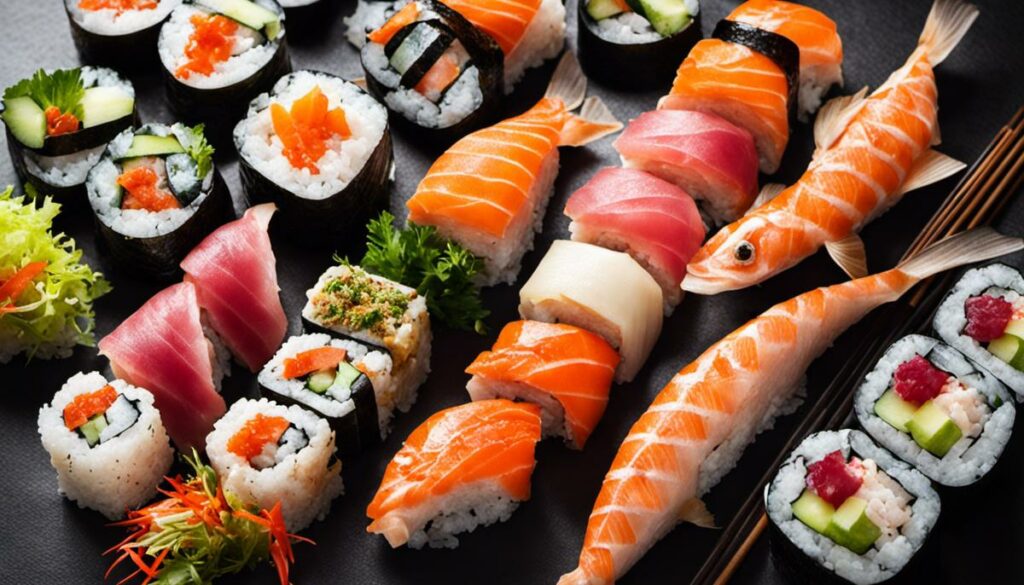Originating directly from the magnificent culture of Japan, sushi has achieved its unique place in the culinary world. This in-depth essay looks back at the multi-layered history of sushi, which has been polished over time like a pearl in the ocean of cultural exchange between nations. We also raise the curtain on the wide range of sushi styles, each with its own unique charm and taste. Plus, with unparalleled care, we give an in-depth look at the intricacies of sushi indulgence, a way of eating that is more than just food intake – it’s an art form in itself.
The History of Sushi
Sushi: a delicate symphony of taste and tradition
Deep-rooted traditions flow inextricably with sushi, a culinary work of art that has conquered the world. But when you get to the origin of this dish, you discover that its journey has undergone an impressive development.
It all starts in Southeast Asia, where people started fermenting fish into rice to make it last longer. This oldest sushi called Narezushi was less of a delicacy and more of a matter of practical use.
In the 8th century, these fish hopped to Japan and quickly gained popularity. The Japanese found the ripe taste of narezushi appealing and began to make it a staple in their culinary repertoire.
When Namanare appeared in the 14th century, sushi was barely recognizable. Fish was served in a semi-fermented state, resulting in a delicate flavor that was far from the narezushi. The 19th century brought hayazushi to the world and with it the attention to the rice instead of just the fish.
Tokyo, then known as Edo, became the birthplace of modern sushi as we know and love it. As fast-food restaurants emerged, sushi quickly went from “bento”-like boxes to an art form where aesthetics were as important as taste.
Sushi has undergone a complete transformation over the years and is now a culinary symbol. Today’s variety of roles and the variety of ingredients symbolize the process of mutual cultural recognition.
Sushi is a culinary journey that is remarkable! It has transformed into the highly stylized and complex roles presented to us today in fine dining, yet deeply rooted in tradition, culture, and history. It is also a testimony to how gastronomy is evolving and adapting to our lives, honoring old traditions while offering us something new.
This seemingly simple dish has evolved over the centuries to meet the expectations of the most demanding palates, while maintaining its essence. Sushi – a wonderful symphony of tradition, innovation and taste!

Different types of sushi
As we continue to explore this fascinating topic, our focus is now on the different types of sushi that can be discovered around the globe. The awareness of the aesthetic design and matching taste inherent in each piece of sushi is crucial to appreciating the art behind it.
The nigiri zushi is probably the most famous type of sushi. This consists of oval rice balls garnished with a slice of raw or cooked fish. Although the combinations are almost endless, salmon and tuna are the most common toppings on the nigiri zushi.
Another popular variation is the maki zushi, where rice and toppings are rolled into a nori sheet (dried seaweed) and finally cut into smaller pieces. Maki-zushi can come in numerous variations. The futomaki roll is wide and contains various ingredients, while the hosomaki roll is smaller and usually contains only one ingredient.
Uramaki zushi, a Western interpretation of traditional sushi, inverts the usual structure of maki zushi by placing the rice on the outside and the nori sheet on the inside. This allows for creative flavor combinations and an appealing aesthetic appearance.
Temaki-zushi, known as hand rolls, is another form of sushi that is very different. They are formed from nori sheets that are rolled into a bag and then filled with rice and other ingredients.
Finally, there’s the chirashi zushi, where the rice is served in a bowl and sprinkled with various ingredients. It is known for its appealing presentation and luscious flavor.
Although all of these types of sushi have their origins in Japanese cuisine, they have been adapted and developed worldwide to meet the needs and taste preferences of a global audience. Of course, this is also a tribute to the innovative spirit of the sushi masters and the versatile nature of this wonderful cuisine.
Today’s fascination and popularity of sushi only underscore the relevance of this art in the global gastronomy scene. It has evolved from its traditional origins in Japan to a worldwide speciality that delights both discerning connoisseurs and simple food lovers.

The Right Sushi Experience: Etiquette and Pairings
Next, we come to the most important part: how to enjoy sushi properly and what drinks go best with it. Every sushi friendship starts with the first bite – you should definitely enjoy this on a culinary journey full of sensual impressions hidden behind every bite of sushi. Each part of the bite-sized morsel is finely tuned, allowing flavors and textures to blend harmoniously.
Let’s start with the handling of the famous chopsticks – if you think of wobbling and falling sushi rolls, you haven’t learned the proper technique yet. The right hand is the more active one when eating sushi, while the left hand holds the sushi. With your right hand, gently guide the chopsticks to be able to pick up the sushi undamaged. The tops of the chopsticks must not scratch the plate – a disturbing noise and a real no-go at the traditional sushi tasting. Skilful manipulation of the chopsticks prevents the precious sushi morsels from falling apart and preserves the perfect sushi aesthetic.
The soy sauce is not a soup pot – the sushi should only be lightly dipped and never soaked!! become. Too much soy sauce masks the subtle nuances of the sushi ingredients and has a negative effect on the delicate, earthy taste of the sushi rice. Also, refrain from using too much wasabi or pickled ginger, as these strong flavors can suppress the authentic flavor of the sushi.
When it comes to drinks that go well with sushi, sake is often the first choice, but far from tradition and classicism, we arrive at more refreshing and perhaps more surprising drinks. Green tea, known as sencha or matcha, not only serves as a thirst quencher during a sushi meal, but balances and complements both the sweetness and the more zesty and fishy flavors of sushi. Japanese beer can also be a wonderful combination for sushi, it delivers a clear, fresh palette that breaks down fatness and gets the palate ready for the next bite.
For the wine lovers among the sushi enthusiasts, a well-chilled white wine would be an excellent choice. A crisp, dry drink such as a fine Chablis or a tangy Sauvignon Blanc can harmonize beautifully with the rich, maritime notes of raw fish. If sushi is replacing your cheese platter, you might also consider a light, fruity red wine.
In conclusion, the consummate and conscious tasting of sushi feels like a philosophy that invites you to engage with the art and nuances of taste. It’s about more than just satisfying hunger. It’s about enjoying complex textures and flavors, an experience that is intensified by the right choice of drinks.

There remains no doubt that sushi is a representative symbol of Japan’s rich culture and history. Its refined art and craftsmanship have managed to capture the hearts of gourmet lovers around the world. It is not only a culinary marvel appreciated for its exquisite taste, but also a testament to the appreciation of aesthetics and ritual experience in Japanese culture. Sushi connects people, tells stories and opens a window into a fascinating world of taste experience that goes far beyond just eating.


